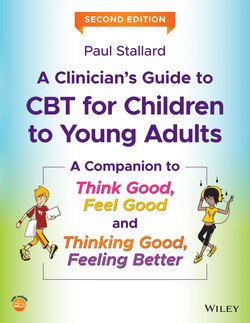Читать книгу A Clinician's Guide to CBT for Children to Young Adults - Paul Stallard - Страница 24
Outcome‐focused
ОглавлениеThe CORE philosophy promotes a hopeful, future‐orientated approach with a clear emphasis on outcomes, goals, and objective measurement. From the first session, the young person is encouraged to think about the future, their goals, and how things would be different if they no longer had their problems.
Typically, young people do not refer themselves for help and may not necessarily share the concerns and goals of those who referred them. This is often exemplified with school non‐attendance, where the objective of the parent and school in securing the young person’s school attendance may not be the main priority of, or indeed a goal shared by, the young person.
Young people may also be unable to think about how things could be different or identify any goals. This is a common problem with young people who become very familiar with their current situation and are unable to think about how this could change. Similarly, previous experience with adults may lead young people to assume a passive role in which they expect others to identify their problems and to tell them how they need to change, without necessarily having any ownership of either the problem or the change process.
Helpful techniques for eliciting goals are discussed in Chapter 3 (Assessment and goals). For example, the miracle question offers a future‐orientated way of helping the young person to consider what their life may be like if all their problems miraculously disappeared overnight. This visualisation of a problem‐free future offers the potential to identify what might need to change to achieve this. In many cases, desired outcomes may appear daunting or feel too large or unachievable, and this can be demotivating. In order to maintain motivation, outcomes can be broken down into a series of smaller, more manageable, goals. The successful achievement of each goal takes the young person closer towards their overall objective. Goals should be specific, measurable, achievable, relevant, and timely (SMART), thereby clearly and positively identifying what the young person hopes to achieve. The identification of clear goals ensures that the intervention remains focused and that the young person and clinician are explicitly working towards agreed objectives.
In order to maintain momentum, progress should be regularly assessed using rating scales and routine outcome measures. These provide a way of quantifying change and of capturing small, but important, changes that highlight progress. Similarly, the absence of change should prompt a curious discussion with the young person where this is acknowledged, possible reasons or barriers explored, and a plan agreed.
In summary, this future‐orientated approach focusing on outcomes is positive and empowering and from the outset builds a sense of hopefulness and a focus on change. The use of goals and routine outcome measures helps to clarify and quantify achievements, and ensures that the intervention remains focused and the young person motivated.
